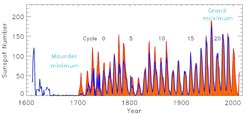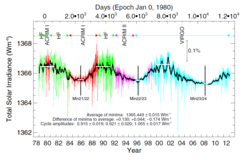
Solar Variability and Climate
The Sun varies on all time scales accessible to observations, from a fraction of a second to centuries, and is expected to change also on longer time scales. At longer time scales of days to centuries the source of solar variability is in one way or another the magnetic field. The major exception is the period of 27.2573 days due to solar rotation. The most prominent solar time-dependent phenomenon is the sunspot cycle or, more generally, the solar activity cycle with a period of roughly 11 years. Within this period of time the number of sunspots emerging on the solar surface (Fig. 1) and the area covered by them increases by over an order of magnitude before dropping again. In spite of many similarities each cycle is distinct from the others, most obviously in amplitude, less obviously in the cycle length, and also in other parameters. The amplitude of the sunspot cycle during the 20th century changed by a factor of up to 3. A much more drastic change happened in the 17th century, when hardly any sunspots were seen during more than 50 years (Fig. 1). This period is called the Maunder minimum.

Over the activity cycle many more observables change than just the number of sunspots or the area covered by them. One of them is the total solar irradiance (TSI), which is the wavelength integrated flux of the Sun measured above the Earth's atmosphere. It changes in step with the sunspots (Fig. 2), as do many more indices and features. The total solar irradiance has been measured since 1978 (using radiometers on-board spacecraft) with sufficient accuracy to detect intrinsic solar changes. In addition to the presence of the 11-year cycle with an amplitude of roughly 0.1%, significantly shorter fluctuations are present which give the diagram a noisy appearance. These fluctuations are mainly solar and the amplitude of this 'noise' changes in phase with the cycle. Variations in solar total and spectral irradiance affect Earth's climate. As direct measurements are only available for 3.5 decades, and climate simulations require significantly longer time series, reconstructions of solar irradiance into the past are crucial for understanding of solar influence on climate and causes of the recent global change.

This research group studies solar variability on timescales of days to Millennia. This includes:
- Quantitative modelling of total and spectral irradiance variations and of the surface magnetic flux
- Reconstructing magnetic flux and irradiance since the Maunder minimum
- Reconstructing magnetic flux, the sunspot number and irradiance over the Holocene
The aim of this research is to understand the physical mechanisms responsible for solar brightness variations and, finally, to predict future variability of the Sun.






